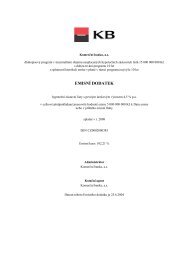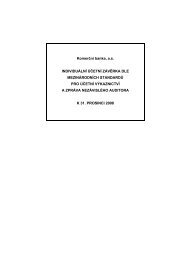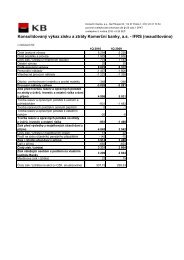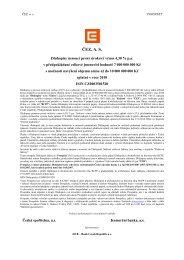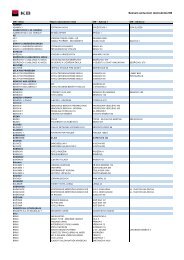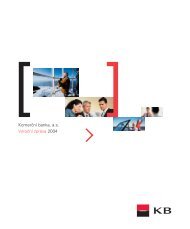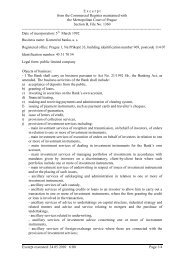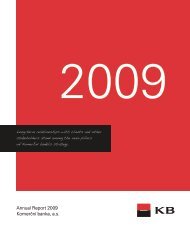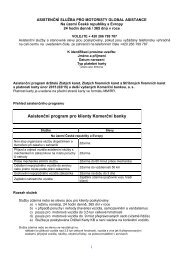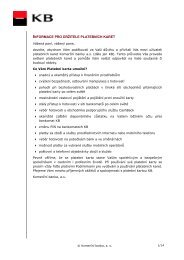KB prezent. angl - Komerční banka
KB prezent. angl - Komerční banka
KB prezent. angl - Komerční banka
Create successful ePaper yourself
Turn your PDF publications into a flip-book with our unique Google optimized e-Paper software.
The Group assesses on a regular basis whether there is any objective evidence that a security carried in the available for sale portfolio<br />
may be impaired. A financial asset is impaired if its carrying amount is greater than its estimated recoverable amount which is equal<br />
to the present value of the expected future cash flows discounted at the financial instrument’s original effective interest rate.<br />
The amount of the impairment loss for assets carried at amortised cost is calculated as the difference between the asset’s carrying<br />
amount and its recoverable amount. When impairment of assets is identified, the Group recognises provisions through the profit and<br />
loss statement line Provision for losses on securities.<br />
(f) Tangible and intangible fixed assets<br />
Tangible and intangible fixed assets are stated at historical cost less accumulated depreciation together with accumulated impairment<br />
losses. Fixed assets are depreciated through the accumulated depreciation charge. Depreciation is calculated on a straight line basis<br />
to write off the cost of each asset to their residual values over their estimated useful economic life. Land and assets in the course of<br />
construction are not depreciated.<br />
The estimated useful economic lives in years are set out below:<br />
Machinery and equipment, computers, vehicles 4<br />
Fixtures, fittings and equipment 6<br />
Energy machinery and equipment 12<br />
Distribution equipment 20<br />
Buildings and structures 30<br />
The Group periodically tests its assets for impairment. Where the carrying amount of an asset is greater than its estimated<br />
recoverable amount, it is written down to its recoverable amount. Where assets are identified as being surplus to the<br />
Group’s requirements, management of the Group determines a provision for an asset impairment. In respect of the assets owned by<br />
the Group, the provision is assessed by reference to a net selling price based on third party valuation reports adjusted downwards for<br />
an estimate of associated sale costs. Leasehold assets are provisioned by reference to the net present value of future costs and the<br />
residual value of any technical improvements.<br />
Repairs and renewals are charged directly to the profit and loss statement when the expenditure is incurred.<br />
(g) Leases<br />
Assets held under finance leases, which confer rights and obligations similar to those attached to owned assets, are capitalised at<br />
their fair value and depreciated over the useful lives of assets. The capital element of each future lease obligation is recorded as<br />
a liability, while the interest elements are charged to the profit and loss statement over the period of the leases to produce a constant<br />
rate of charge on the balance of capital payments outstanding.<br />
Payments made under operating leases are charged to the profit and loss statement on a straight line basis over the term of the<br />
lease. When an operating lease is terminated before the lease period has expired, any payment required to be made to the lessor by<br />
way of penalty is recognised as an expense in the period in which termination takes place.<br />
(h) Provisions for guarantees and other off balance sheet credit related commitments<br />
The Group recognises a provision when, and only when:<br />
– It has a present obligation (legal or constructive) as a result of a past event;<br />
– It is probable that the settlement of the obligation will cause an outflow of resources causing decrease of economic benefits;<br />
– A reliable estimate can be made of the amount of the obligation.<br />
In addition, the Group has established a restructuring provision. The Group recognises a provision for restructuring costs when it has<br />
formulated a restructuring plan, and started to implement the restructuring plan or announced its main features. Information on<br />
restructuring costs identified by the Group is given in Note 11.<br />
In the normal course of business, the Group enters into credit related commitments which are recorded in off balance sheet accounts<br />
and primarily include guarantees, letters of credit and undrawn loan commitments. Specific provisions are made for estimated losses<br />
on these commitments on the same basis as set out in Note 3(d).



